Hypertonic saline - Study guides, Class notes & Summaries
Looking for the best study guides, study notes and summaries about Hypertonic saline? On this page you'll find 2846 study documents about Hypertonic saline.
Page 4 out of 2.846 results
Sort by
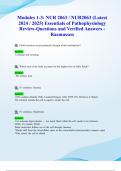
-
Modules 1-3: NUR 2063 / NUR2063 (Latest 2024 / 2025) Essentials of Pathophysiology Review-Questions and Verified Answers - Rasmussen
- Exam (elaborations) • 37 pages • 2024
-
Available in package deal
-
- $10.99
- + learn more
Modules 1-3: NUR 2063 / NUR2063 (Latest 2024 / 2025) Essentials of Pathophysiology Review-Questions and Verified Answers - Rasmussen Q: Fluid excretion occurs primarily through which mechanisms? Answer: Urination and sweating Q: Which area of the body accounts for the highest loss of daily fluids? Answer: The urinary tract Q: IV solutions: Isotonic Answer: 0.9% sodium chloride (NS), Lactated Ringers (LR), D5W (5% Dextrose in Water) The solution outside the cell is...
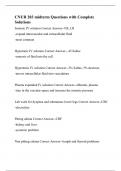
-
CNUR 203 midterm Questions with Complete Solutions
- Exam (elaborations) • 11 pages • 2024
-
- $15.49
- + learn more
Isotonic IV solution Correct Answer--NS, LR -expand intravascular and extracellular fluid -most common Hypotonic IV solution Correct Answer--.45 Saline -osmosis of fluid into the cell Hypertonic IV solution Correct Answer--3% Saline, 5% dextrose -moves intracellular fluid into vasculature Plasma expanded IV solution Correct Answer--albumin, plasma -stay in the vascular space and increase the osmotic pressure Lab work for dyspnea and edematous lower legs Correct Answer--CBC -el...
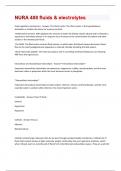
-
NURA 408 fluids & electrolytes Exam Questions With 100% Correct Answers.
- Exam (elaborations) • 19 pages • 2024
- Available in package deal
-
- $8.39
- + learn more
Fluid regulation mechanisms - Answer--The thirst center. The thirst center in the hypothalamus stimulates or inhibits the desire for a person to drink. -Antidiuretic hormone. ADH regulates the amount of water the kidney tubules absorb and is released in response to low blood volume or in response to an increase in the concentration of sodium and other solutes in the intravascular fluids. -The RAAS. The RAA system controls fluid volume, in which when the blood volume decreases, blood flow t...

-
NURS 611 / NURS611 Exam 1 (Latest 2024 / 2025 Update): Advanced Pathophysiology | Complete Guide with Questions and Verified Answers | 100% Correct | Grade A - Maryville
- Exam (elaborations) • 43 pages • 2024
- Available in package deal
-
- $7.99
- + learn more
Exam 1: NURS611 / NURS 611 (Latest 2024 / 2025 Update) Advanced Pathophysiology Exam Review | Complete Guide with Questions and Verified Answers | 100% Correct | Grade A - Maryville Q: ADH (water retention) and perception of thirst are stimulated by? Answer: Increased plasma osmolality Q: Osmolality increases or decreases with dehydration? Answer: Increases Q: Osmolality increases or decreases with over hydration Answer: Decreases Q: What is a normal sodium level? Answer: 135-145 meq/l Q: Sodium...
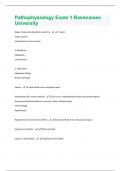
-
Pathophysiology Exam 1 Rasmussen University (Quizzes With Correct Ans) Already Passed!!
- Exam (elaborations) • 28 pages • 2024
- Available in package deal
-
- $7.99
- + learn more
Stages of general adaptation syndrome - 1. Alarm Initial reaction Sympathetic nervous system 2. Resistance Adaptation Limit stressor 3. Exhaustion Adaptation failing Disease develops Edema - Excess fluid in the interstitial space Dehydration (ECF volume deficit) - Can occur independently without electrolyte defects Decrease in fluid level leads to increase in level of blood solutes Cell shrinkage Hypotension Hypovolemia or fluid volume deficit - Decreased fluid in the intravascular...
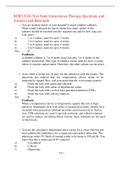
-
NURS 3320 Test Bank Intravenous Therapy Questions and Answers and Rationale,100% CORRECT
- Exam (elaborations) • 23 pages • 2022
-
- $15.99
- 1x sold
- + learn more
NURS 3320 Test Bank Intravenous Therapy Questions and Answers and Rationale 1. You are training nurses at your hospital to insert midline catheters. What would you teach the nurses about how many inches of the catheter should be inserted into the required site and for how long can it be used? A) 1 to 3 inches, used for up to 3 weeks B) 3 to 6 inches, used for up to 4 weeks C) 7 to 8 inches, used for up to 5 weeks D) 8 to 9 inches, used for up to 6 weeks Ans: B Feedback: A midline cathete...
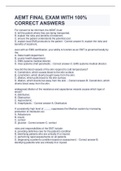
-
AEMT FINAL EXAM WITH 100% CORRECT ANSWERS
- Exam (elaborations) • 14 pages • 2022
-
Available in package deal
-
- $16.99
- 3x sold
- + learn more
For consent to be informed, the AEMT must: A. tell the patient where they are being transported. B. explain the risks and benefits of treatment. C. ensure the patient understands the potential cost. D. explain local EMS protocols to the patient - Correct answer-A. explain the risks and benefits of treatment. even with an EMS certification, your ability to function as an EMT is governed locally by the: A. State health department. B. county health department. C. EMS systems medical direc...
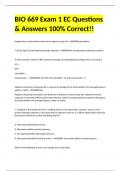
-
BIO 669 Exam 1 EC Questions & Answers 100% Correct!!
- Exam (elaborations) • 58 pages • 2024
-
- $13.99
- + learn more
Hypotension, tachycardia and low urine output are signs of - ANSWERhypovolemia 7.36 ph, high CO2 and high bicarbonate indicates - ANSWERfully compensated respiratory acidosis If water consists of 60% of TBW. Choose and assign corresponding percentages (40, 5,15 and 20). ICF = ECF= Interstitial = Intravascular = - ANSWERICF=40; ECF=20; Interstitial = 15 and Intravascular = 5 Adaptive Immunity is programmed to respond to damage to the body whether the damaged tissue is septic or steri...

-
Exam 1: NR324/ NR 324 (New 2024/ 2025 Update) Adult Health I | Weeks 1-3 Complete Guide with Questions and Verified Answers | | 100% Correct | A Grade - Chamberlain
- Exam (elaborations) • 53 pages • 2024
-
Available in package deal
-
- $11.49
- + learn more
Exam 1: NR324/ NR 324 (New 2024/ 2025 Update) Adult Health I | Weeks 1-3 Complete Guide with Questions and Verified Answers | | 100% Correct | A Grade - Chamberlain QUESTION Hypotonic Fluids Answer: 0.45% NaCl (1/2 saline) D5W (isotonic in the bag and hypotonic in the body) QUESTION When is 0.45% Nacl used? Answer: used to treat hypernatremia QUESTION caution with 0.45% Nacl Answer: may cause fluid volume overload do not use in burns or traum...

-
ATLS10 exam questions with answers (answers outlined!!)
- Exam (elaborations) • 15 pages • 2023
-
Available in package deal
-
- $15.49
- 1x sold
- + learn more
ATLS10 exam questions with answers (answers outlined!!) 1. A 24-year-old male pedestrian, struck by an automobile, is admitted to the emergency department 1 hour after injury. His blood pressure is 80/60 mmHg, heart rate 140 beats per minute and respiratory rate is 36 per minute. He is lethargic. Oxygen is delivered via face mask, and two large-caliber IVs are initiated. Arterial blood gases are obtained. His PaO2 is 118 mmHg (15.7 kPa), PaCO2 is 30 mmHg (4.0 kPa), and pH is7.21. The treat...

How did he do that? By selling his study resources on Stuvia. Try it yourself! Discover all about earning on Stuvia


